Ever stared at unsightly stains seeping through your perfect paint job? Discover the secret to banishing wood knot bleed-through for good! How? Dive in!
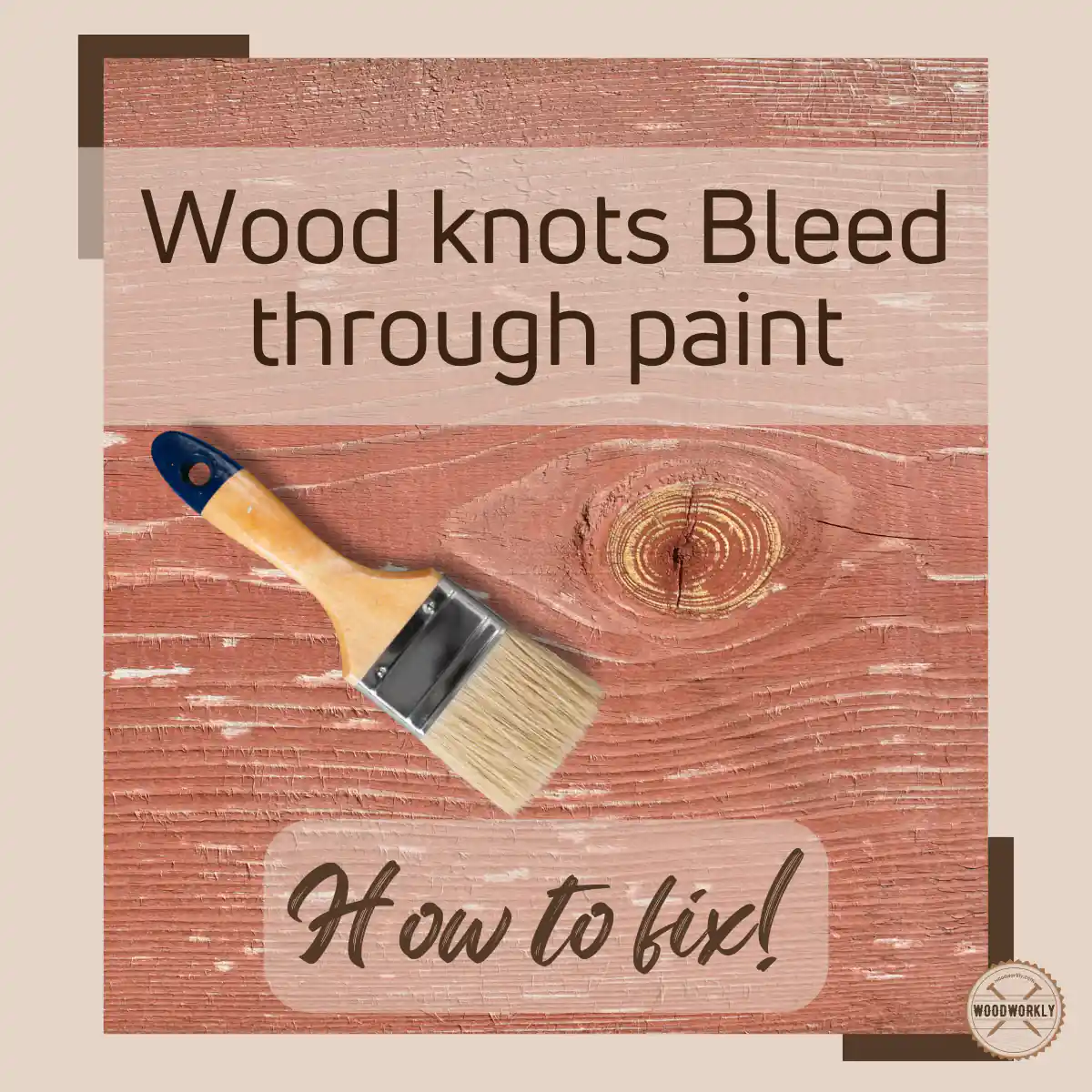
Tired of wood knots ruining the finish of your beautifully painted wooden projects?
Once, I’ve been there too!
When I first started my journey in the woodworking industry, I had to face multiple challenges. The issue of wood knots bleeding through paint stood the largest among them all.
Whether it was a brand-new project or giving an old piece of wood a fresh look, those stubborn knots were a real headache those days.
Therefore, I decided to research and seek advice from those with more experience in this subject. Over time, this effort led me to discover effective ways to tackle this problem.

From now on, I’m excited to share the most successful solutions I’ve found for dealing with this wood knot issue.
I’m pretty sure that these tips will answer your problems too.
Here is how to stop knots from bleeding through paint?
To stop knots from bleeding through paint, first, halt sap oozing with a heated paint remover. Sand the area, then apply several coats of a shellac-based primer to seal knots completely. Finish with a quality paint, and for optimal results, opt for dark or oil-based paints to mask potential bleed-through.
This is just a brief overview!
To gain a comprehensive understanding, we need to dive deeper into how to stop knots from bleeding through paint.
Furthermore, I’ll answer some frequently asked questions as well.
Let’s jump in!
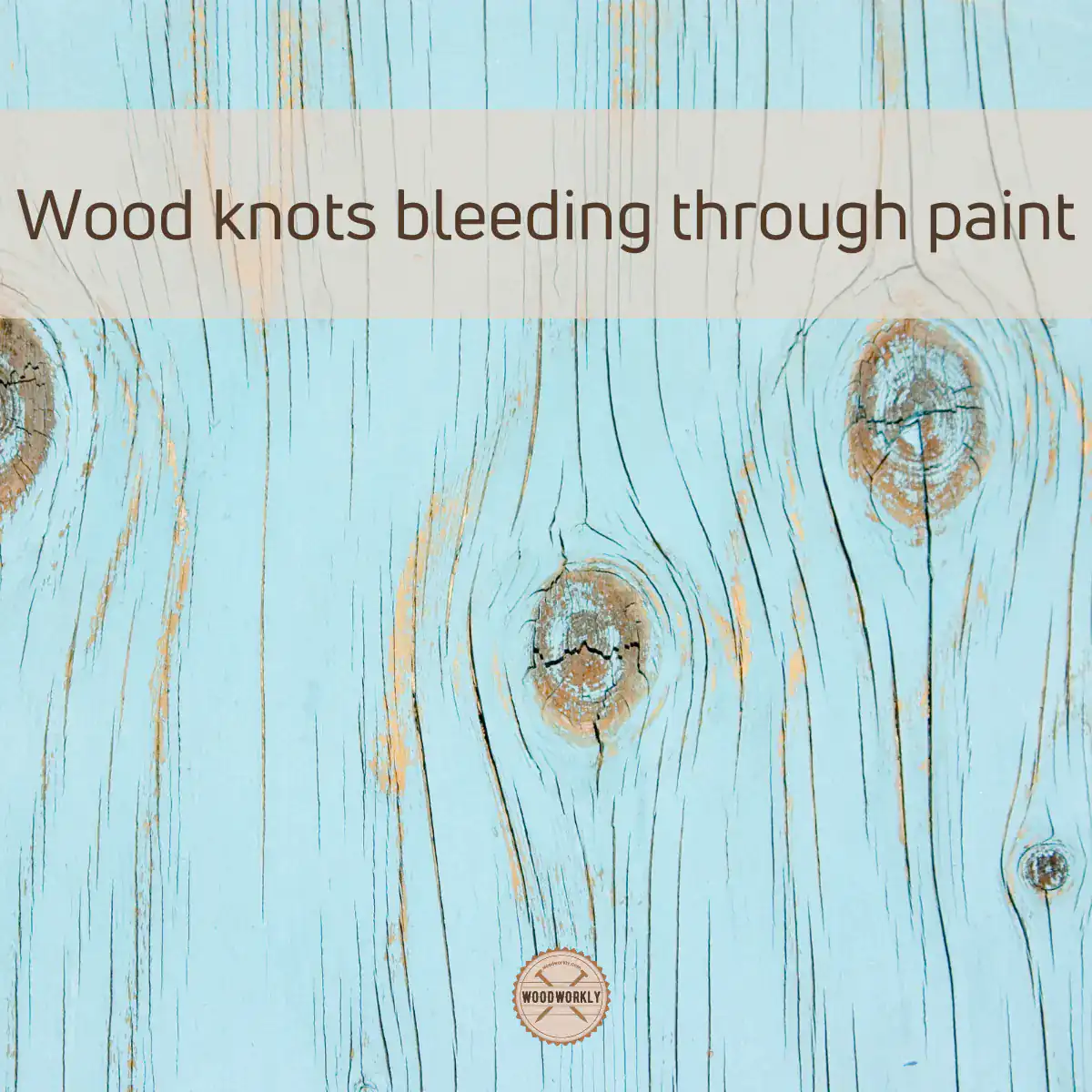
To kick things off, let’s begin by exploring “wood sap.”
What Is Sap From Wood?
If you’re wondering why having an understanding of wood sap is important, it’s because the more you know about the relation between sap and knots, you’ll be able to address the issue of wood knots bleeding through paint.
In the subject of woodworking, sap refers to the sticky substance that flows within the fibres of trees.
It is responsible for carrying nutrients, energy, and minerals throughout the tree.
However, sap flows from branches, leaves, and sometimes even wood. In some cases, this sap can harden and crystallize, making it hard to remove.
This sap is contained in the wood knots of trees.
Over time, this sap can slowly move to the surface of the knot. When that happens, the sap can seep through the wood knot even if it is not on a live tree.
Read to know, How to Stop Sap from Coming Out of Wood!

Can You Paint Over Sap?
Yes, you can! But it will not work out well. Let’s unpack WHY.
The tricky part of sap seeping is that even after you paint, it continues to flow through the paint.
What Happens if We Paint Over Sap?
If you attempt to paint over sap that is thick, and sticky without taking the right precautions, you’re preparing for wasting both your money and time.
The sap will bleed through primers and paints regardless of how many coats you apply.
This leads to stains and a paint job that may look good initially but turns into a mess within a few months.
Why Should You Avoid Painting Over Sap?
To avoid reappearing stains and maintain the beauty of your paint job, it’s best not to paint over sap.
Instead, we’ll explore solutions for addressing the issue of sap and wood knots.
By understanding the root causes of the problem and implementing the correct techniques, you can ensure a smooth, long-lasting finish to your woodworking.
So, let’s move on to Why Do Knots Bleed Through Paint and how to stop it.
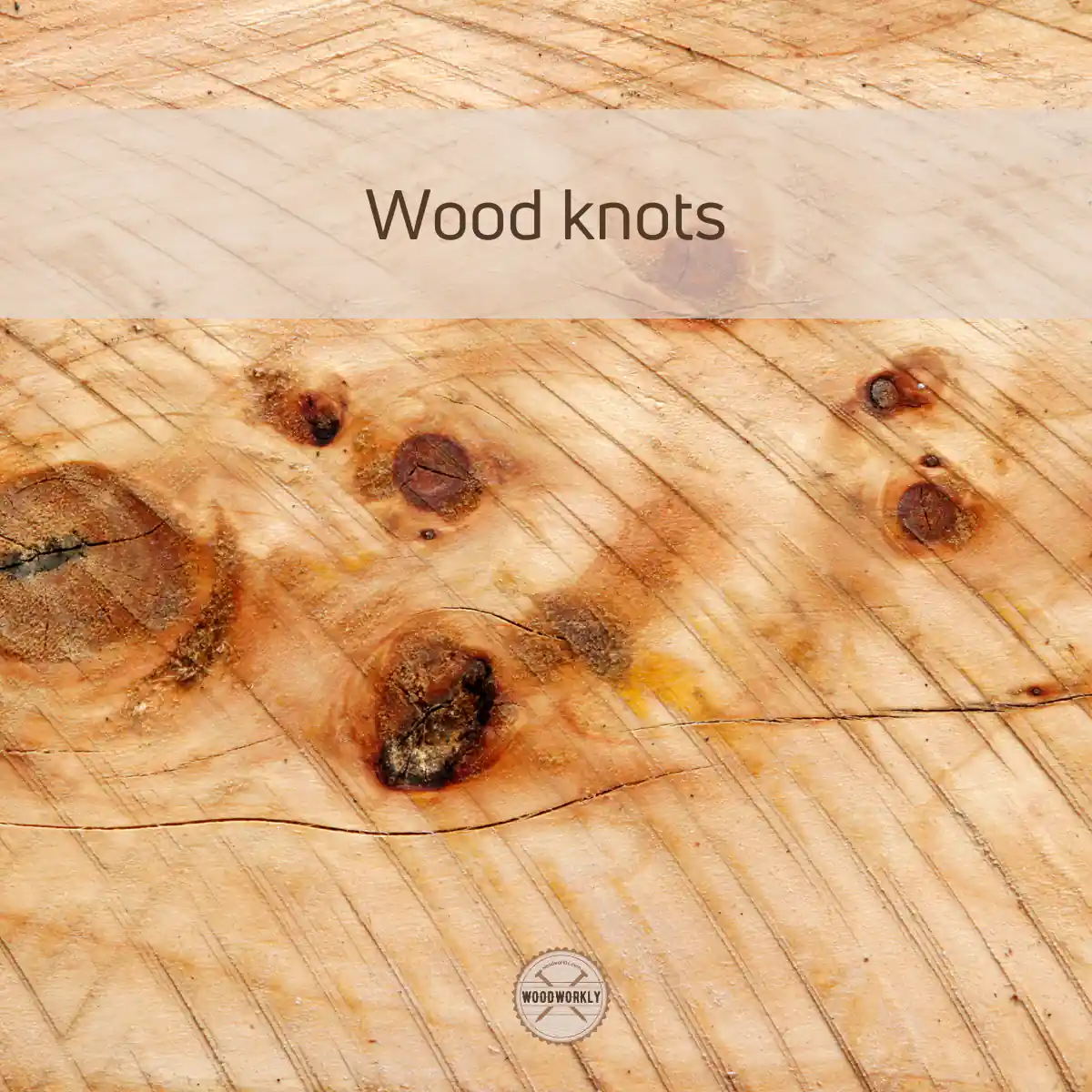
Why Do Knots Bleed Through Paint?
Understanding why wood knots tend to bleed through paint is crucial to preventing this issue and achieving a flawless finish on your wooden surfaces.
Let’s explore the reasons behind this problem.
- Resin-Containing Knots
- Sap and Tannins
Resin-Containing Knots
This issue primarily affects woods with knots that contain resin, such as pine, spruce, and fir.
The solvents in coatings can dissolve the resin. Thus, it’s important to note that knot bleeding is distinct from resinous exuding, which occurs under heat or sun.
In the latter case, resin seeps through the coating, resulting in a yellowish tint after a few months.
Sap and Tannins
Wood knots are not just about resin; they also contain sap and tannins. These components can seep through paint, leading to unsightly discoloration.
When knots are not properly sealed before painting or staining, they can bleed through the paint, causing visible stains and ruining your wooden project finish.
Understanding the reasons behind knot bleeding is the first step in effectively preventing wood knots from bleeding through paint.
Now, I’m going to share with you the most insightful section in this guide.
It is a detailed discussion of practical strategies and solutions to ensure that your woodworking projects inherit a beautiful finish.

How To Stop Knots From Bleeding Through Paint
Dealing with wood knots from bleeding through paint can be a real struggle, but there are effective steps you can take to ensure your paint job turns out even and flawless.
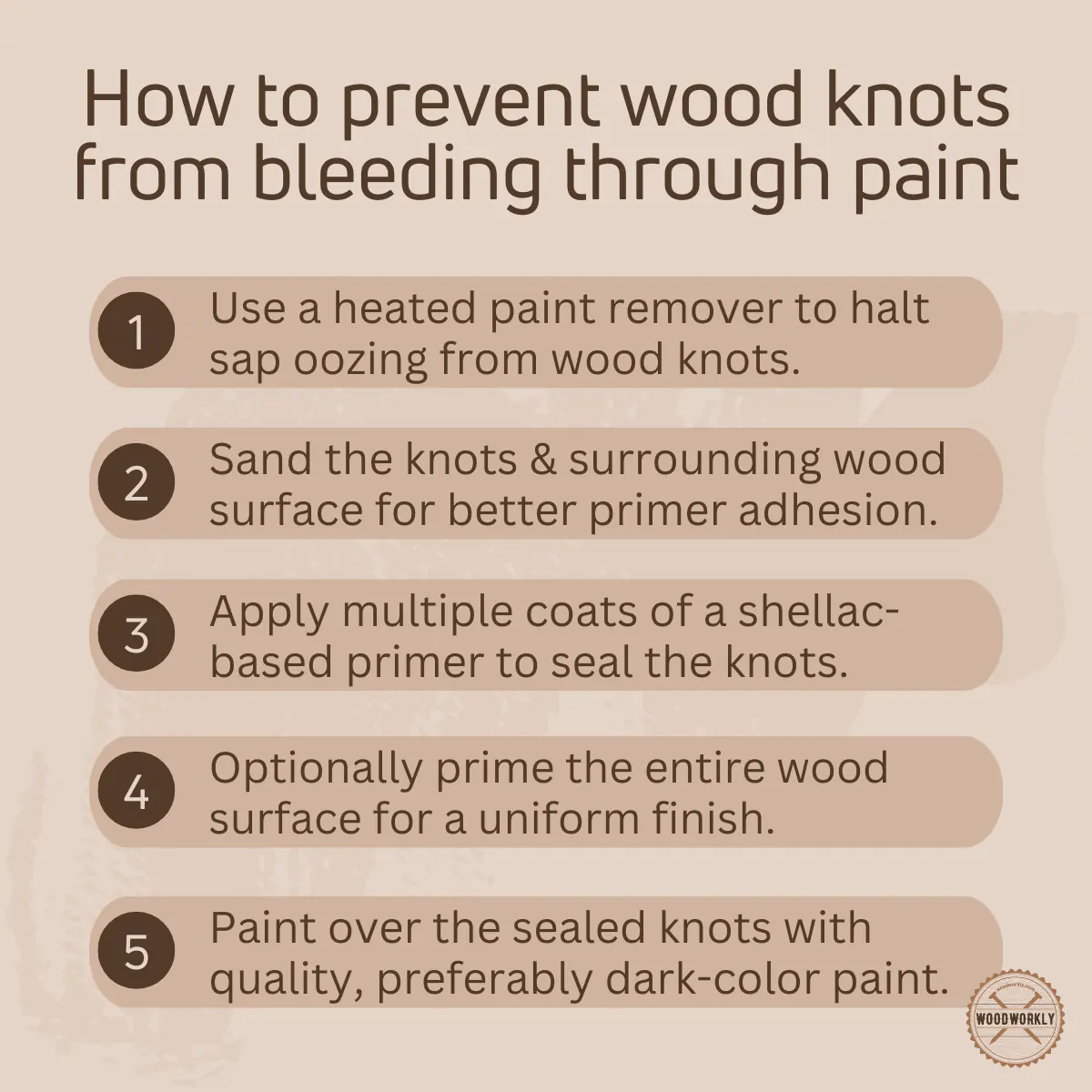
In this section, we’ll explore the key three essential steps you should follow to prevent wood knots from ruining your projects.
- Stop Wood Knots From Oozing Sap
- Sanding the Wood
- Apply a Shellac-Based Primer
1. Stop Wood Knots From Seeping Sap
If a knot is identified in the selected piece of wood that is leaking sap, the must be taken to stop the bleeding before proceeding. Because you can’t paint over sap.
Even if it does, it won’t help because the sap will run through your paint and still bleed.
That means it’s important to stop the knot from leaking sap before painting. One way to do that is to use a heated paint remover.
Using a heated paint remover can warm the sap and cause it to flow onto the surface. The juice that flows out hardens on the surface of the knot. After that, it can be removed.
But here the hardened sap is likely to solidify like a stone, so be careful with it. Because if it does it will be difficult to remove.
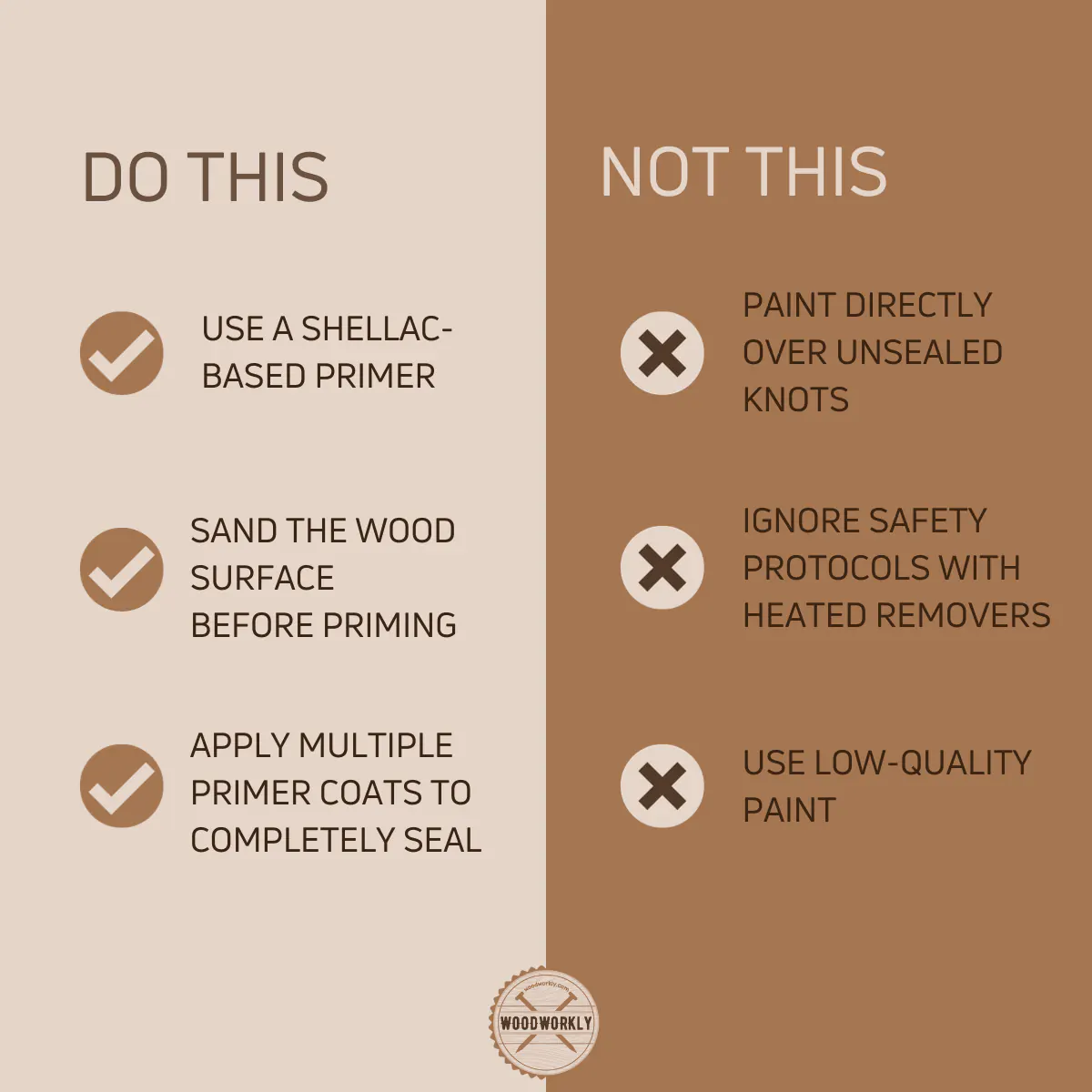
2. Sanding the Wood
Properly sanding the project is the second key to preventing wood knots from bleeding through paint.
The goal here is to prepare the surface so that the primer can adhere effectively.
To begin, assess the condition of the surface and choose the suitable sandpaper grit size.
If it’s rough, start by using 80-grit sandpaper.
However, for most projects, commencing with 100-grit sandpaper is a good practice. Then, finish up with 120-grit sandpaper.
1. Preparations For Sanding
Now, you begin the sanding process. But before that, make sure you have taken the below preparations.
- Lay down a sheet to cover your working space.
- If you’re working with a larger piece of wood, consider working in a spacious area like an open garage.
- If you’re working indoors, ensure proper ventilation to avoid inhaling fumes.
2. Identification of Knots
Next, identify all the knots on the wood. These are usually darker spots on the surface, easily distinguishable on new wood or slightly darker than the rest on older pieces.
Each of these knots needs to be covered with a stain blocker.
3. Begin The Sanding Process
To prepare the knots for treatment, use 120-grit sandpaper. This serves a dual purpose.
- Evens out the surface.
- Enhances adhesion for the stain blocker.
Sand the knots using circular motions, ensuring that you cover the entire area that will be painted.
If you’re planning to paint the entire piece of wood, it is not necessary to cover the knots. But it can help in achieving an even paint layer, ensuring a consistent finish across the entire project.
3. Apply a Shellac-Based Primer
One of the most crucial steps in preventing knots from bleeding through paint is to apply a shellac-based primer, such as Zinsser BIN Primer.

To ensure the knots are completely sealed, applying three coats of primer is recommended by many experts in the field. Also, I have personally experienced it.
If you’re curious about applying shellac, check out my latest guide about How To Apply Bulls Eye Shellac in 7 EASY Steps!
Be careful about the brush you use here. Some foam brushes can dissolve when in contact with shellac.
If you want to explore alternative options, you can purchase a stain-blocking primer or knotting solution.
- For example, consider Oil-based primers. They are also good stain blockers. However, these primers are not as good on shiny or difficult surfaces as Shellac-based primers.
After allowing the primer to dry, apply a second coat, and then a third if necessary.
Typically, three coats should suffice, but don’t hesitate to add more if you can still see the knot.
Once the final coat is dry, lightly sand the shellac surface to remove any brush marks.
Following these three steps can help you prevent wood knots from bleeding through paint and ensure an aesthetic finish for your project.

Furthermore, I will bring you a detailed explanation of the precise steps and techniques involved in painting over a knot
How To Paint Over Knots
Once you’ve diligently followed the steps to prevent wood knots from bleeding through your paint, it’s time for the final touch—painting over knots.
Can You Paint Over Knotting?
Of course, you can paint over knots with water-based paints like latex or oil-based paints, such as alkyd-based paint.
But, make sure to seal knots before painting. You can use a knotting solution for that.
Here I have brought you examples of some standard knotting solutions.
- White Shellac Knotting Solution (bleached)
- Patent Shellac Knotting Solution
- Zinsser BIN Primer
Considerations for Painting
After you’ve effectively sealed the knots, you’re ready to paint.
1. Select the Right Paint:
Make sure the paint you choose is compatible with wood surfaces.
2. Pour Paint into a Tray:
To make the application process smoother, especially when using a roller, pour a small quantity of paint into a tray.
This helps you maintain control over the paint and ensures an even application.
3. Use Back-and-Forth Strokes:
When applying the paint, whether with a roller or a paintbrush, use back-and-forth strokes to create a consistent and even layer.
This technique helps avoid drips and provides a uniform finish.
4. Apply Two Coats:
After the first coat of paint, allow it to dry completely, which usually takes at least an hour.
Then, apply a second coat of paint just like you did with the first and let it dry too.
Read to know, Does Paint Dry Darker or Lighter? (Here’s the Truth!)
By following these steps, you can effectively paint over knots and achieve a smooth, uniform finish.
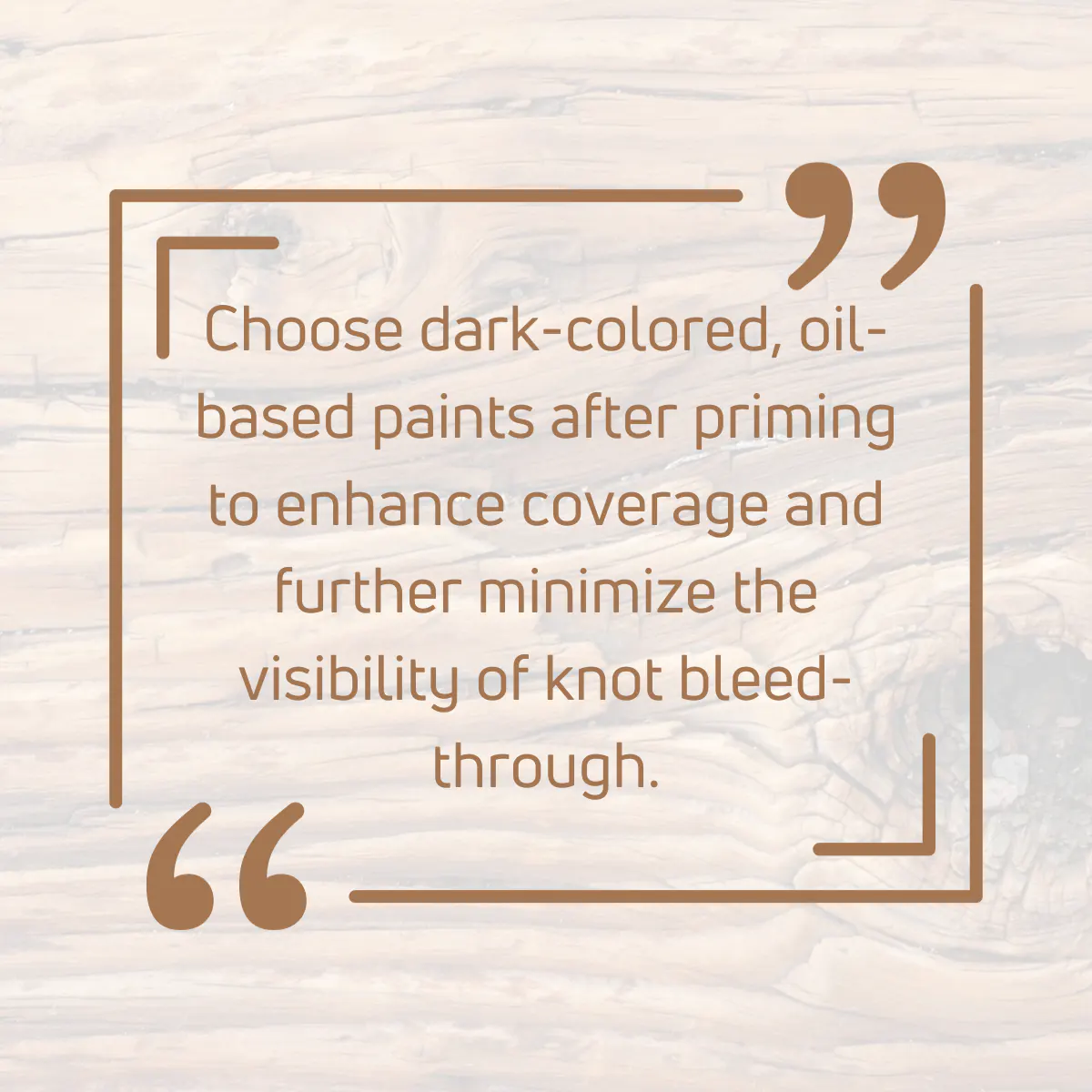
Tips To Prevent Wood Knots From Bleeding Through Paint
Let’s recap the essential tips to keep in mind throughout this process to ensure a successful project!
Awareness of the Moisture Levels:
This knowledge will help determine the wood’s level of dryness and suitability for your project.
Proper Knot Sealing:
Before you even think about applying paint, ensure that knots are properly sealed.
Multiple Primer Coats:
Knots can be stubborn, and one coat of primer might not be sufficient.
Apply multiple coats of the shellac-based primer until the knots are completely concealed.
Consider Entire Project Priming:
If you’re working on a new project, it’s a good practice to prime the entire project with latex primer after sealing the knots.
This extra step ensures that the knots have a minimum of four coats of primer, making it even more difficult for them to bleed through.
High-Quality Paint:
Invest in high-quality paint for your wood projects which are designed to provide a durable finish on wood surfaces.
Matching Paint Color:
When you’re touching up knots or specific areas, make sure the paint closely matches the existing colour. This will help hide any repaired areas seamlessly.
Allow Proper Drying Time:
Allowing each paint coat to dry completely before applying the next one is crucial for achieving a durable and long-lasting finish.
Consider a Sealant:
To provide additional protection for your woodwork, consider applying a sealant after you’ve applied the final coat of paint.
A sealant will help preserve the finish and protect it from environmental factors.
And there you have it – a comprehensive guide on how to stop knots from bleeding through paint.
By following the steps and tips outlined in this article, you’ll be well-armed to enjoy your woodworking projects stress-free.
Congrats folks! Now you know exactly how to stop knots from bleeding through paint with experts’ tips.
So, let’s answer frequently asked questions.
FAQs
What Causes Wood Knots to Bleed Through Paint?
Wood knots bleed through paint due to the sap and tannins contained within them. When painted over directly, these substances can seep through the paint, causing unsightly discoloration and stains.
How Can I Identify Wood Knots on a Surface?
Wood knots are identifiable by their distinct rounded shape and raised appearance on the wood surface. They are remnants of where branches or limbs were once connected to the tree.
Can I Paint Directly Over Wood Knots?
No, painting directly over wood knots without proper preparation can lead to bleed-through. It’s essential to seal and prime the knots effectively before applying the paint.
What Kind of Primer is Best for Sealing Wood Knots?
Shellac-based primers like Zinsser BIN are highly recommended for sealing wood knots. They create an effective barrier to prevent sap and tannins from bleeding through the paint.
Is Sanding Necessary Before Applying Primer to Wood Knots?
Yes, sanding is crucial to roughen the surface of the wood knots, promoting better adhesion of the primer. It ensures the primer effectively seals the knot, preventing bleed-through.
How Many Coats of Primer are Needed to Seal Wood Knots Effectively?
Applying at least three coats of a shellac-based primer is often necessary to thoroughly seal wood knots. Ensure each coat is dry before applying the next to achieve the best results.
Can Oil-Based Paints Be Used to Paint Over Sealed Wood Knots?
Yes, oil-based paints can be used after sealing the knots, and dark-colored paints, in particular, can help mask any potential bleed-through effectively.
What Precautions Should Be Taken When Using a Heated Paint Remover to Stop Knots from Oozing Sap?
Safety is paramount; always follow the manufacturer’s instructions when using a heated paint remover. Ensure proper ventilation and handle the equipment with care to avoid accidents.
Why is it Important to Use a Quality Paint Over Sealed Knots?
Using quality paint ensures a durable and aesthetically pleasing finish. It complements the sealing and priming process, enhancing the longevity of the paint job.
How Do I Ensure a Uniform Finish When Painting Over Sealed Knots?
Achieve a uniform finish by applying paint in even strokes and allowing each coat to dry thoroughly before applying the next. Proper preparation and priming of knots are also vital to ensure consistency.
Did I cover all you wanted to know about: How to Stop Knots From Bleeding Through Paint
In this article, I’ve deeply discussed, how to stop knots from bleeding through paint in detail using the right method with causes and fixes.
Seal wood knots to prevent bleed through by first using a heated paint remover to stop sap oozing. Sand the surface, apply three coats of a shellac-based primer like Zinsser BIN, and allow each to dry before painting. Opt for quality paint to ensure a durable and aesthetic finish.
Furthermore, I’ve answered some frequently asked questions.
Hope you’ve learned all you wanted to know about how to stop knots from bleeding through paint based on my personal experiences and the tips I gathered by interviewing several woodworking experts.
Now it’s time to select your wood, pick up your painting tools, and transform that blank wood into a masterpiece. Happy knot painting!